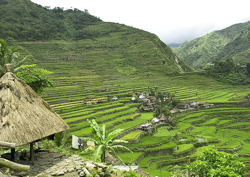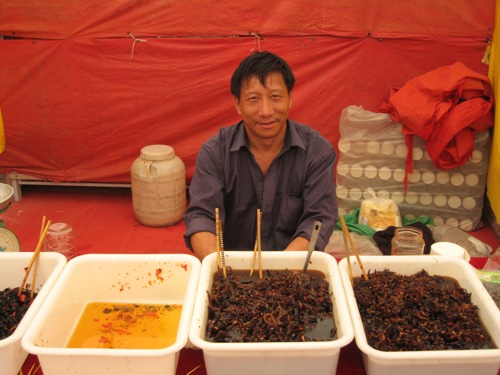More of one of our favourite leitmotifs. Lois Englberger tells me her team’s latest paper on variety-level nutritional composition has been accepted by the Journal of Food Composition and Analysis 1. It won’t actually be out for a few months, but here’s the abstract to whet your appetite:
Lose the farmers, lose the environment
 Further to Luigi’s thoughtful article on how hard farming is becoming, and how the skills needed to farm effectively are being lost as young people abandon rural life for the city, news that a farming environment often considered the eighth wonder of the world is under threat. The Banaue Rice Terraces of Luzon in the Philippines are beyond words. But they are apparently being destroyed by giant earthworms and edible snails, among other pests. But honestly, if the people are introducing snails to supplement their diet, how sustainable can the terraces possibly be? Only human labour can sustain such artifice, and only human need can command and coordinate that much labour. The President of the Philippine Senate has called for a “comprehensive study”. But what is it likely to recommend? That maintaining the terraces be a government-funded job to keep a tourist attraction in a state that will attract tourists, and their cash? Or can the communities that have inherited the Banaue terraces somehow be shown ways in which they can benefit directly from the tourist cash?
Further to Luigi’s thoughtful article on how hard farming is becoming, and how the skills needed to farm effectively are being lost as young people abandon rural life for the city, news that a farming environment often considered the eighth wonder of the world is under threat. The Banaue Rice Terraces of Luzon in the Philippines are beyond words. But they are apparently being destroyed by giant earthworms and edible snails, among other pests. But honestly, if the people are introducing snails to supplement their diet, how sustainable can the terraces possibly be? Only human labour can sustain such artifice, and only human need can command and coordinate that much labour. The President of the Philippine Senate has called for a “comprehensive study”. But what is it likely to recommend? That maintaining the terraces be a government-funded job to keep a tourist attraction in a state that will attract tourists, and their cash? Or can the communities that have inherited the Banaue terraces somehow be shown ways in which they can benefit directly from the tourist cash?
Photo from Wayfaring Travel Guide (because Flickr doesn’t work too well here in China.)
Are farmers a dying breed?
I didn’t go looking for this. These three stories came to me independently, from different sources, from different parts of the world, but all within a day or two of each other. And all describing agriculture in crisis.
Market diversity

Markets are fascinating. Wherever I go in the world, I consider it a real treat to be able to wander very slowly through the markets, seeing what there is, seeing whether I can identify things I’ve only read about, just soaking it up. Kunming is no exception.
Starch and human diversity
Human diversity and agricultural biodiversity interact. The variation that exists between and within crops and livestock products in nutritional content is to some extent matched by — and indeed there is evidence that in some cases it has driven — genetic variation between and within the human populations that make use of them. We’ve blogged about this with regard to lactose intolerance and predisposition to iron deficiency. Now comes a study 2 linking variation among human populations in the number of copies of the amylase gene with the amount of starch in their diet 3